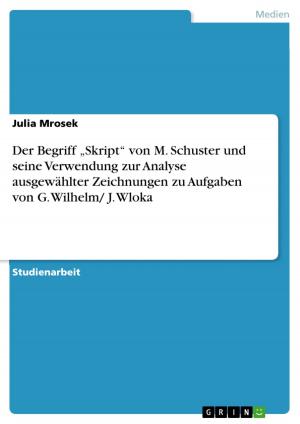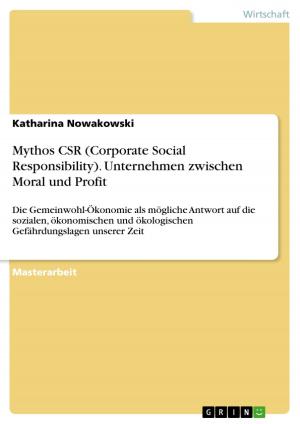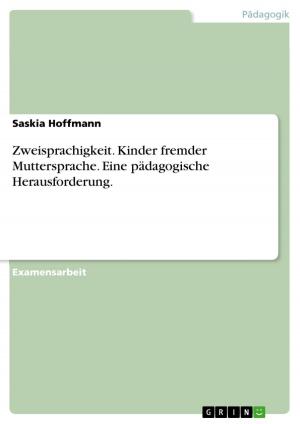Focusing (Differences in) Conversational Discourse Speech Acts
Nonfiction, Entertainment, Drama, Anthologies| Author: | Geiser Patrick | ISBN: | 9783640569557 |
| Publisher: | GRIN Verlag | Publication: | March 19, 2010 |
| Imprint: | GRIN Verlag | Language: | German |
| Author: | Geiser Patrick |
| ISBN: | 9783640569557 |
| Publisher: | GRIN Verlag |
| Publication: | March 19, 2010 |
| Imprint: | GRIN Verlag |
| Language: | German |
Studienarbeit aus dem Jahr 2006 im Fachbereich Anglistik - Linguistik, Note: 1,7, Albert-Ludwigs-Universität Freiburg, Sprache: Deutsch, Abstract: Index I. Introduction II. Clause as Exchange- The Nature of Dialogue III. Discourse Analysis According to Michael Stubbs IV. Surface Cohesion and Underlying Coherence - Indirection in Speech Acts according to John R. Austin 4.1 Utterances as Actions 4.2 Discourse Acts and Speech Acts 4.3 Identifying Speech Acts 4.4 Speech Acts and Social Roles V. Speech Act Analysis according to John R. Searle VI. Conclusion VII. Bibliography I. Introduction Discourse analysis is the general term for a number of approaches to analyze written or spoken language. Discourse Analysis began to develop in the late 1960s and 1970s in most of the humanities and social sciences and in relation with semiotics, psycholinguistics, sociolinguistics, and pragmatics. The object of discourse analysis is defined in terms coherent sequences of sentences, propositions, speech acts or turns-at-talk. In opposite to traditional linguistics, discourse analysts not only study language use beyond the sentence boundary, but also prefer to analyze naturally occurring language use, and not invented examples. Whereas earlier studies of discourse mainly focused on the abstract structures of written texts, many contemporary approaches, especially those influenced by the social sciences, favour a more dynamic study of spoken talk in interaction. Often a distinction is made between local structures of discourse, such as relations between sentences, and global structures, such as the overall topics and the schematic organization of the discourse or conversation as a whole. This term paper will first of all deal with the nature of dialogue and show how interaction functions. In my second chapter I will have a closer look on discourse according to how Michael Stubbs, who teaches courses in general and applied linguistics, lexicology, grammar; semantics and pragmatics, text and corpus analysis, varieties of English, stylistics, sociolinguistics, the sociology of language in Britain and language and thought, approaches it. In the following chapter I will deal with the indirection in speech acts. Regarding this I will focus on John Austin's theories of constantives and performatives as well as his distinction between locutionary, illocutionary and perlocutionary acts. Thereupon I will focus on John R. Searle's view which contrasts Austin's characterization of speech acts. In my conclusion I will summarize my chapters as well as compare Austin's and Searle's point of views. [...]
Studienarbeit aus dem Jahr 2006 im Fachbereich Anglistik - Linguistik, Note: 1,7, Albert-Ludwigs-Universität Freiburg, Sprache: Deutsch, Abstract: Index I. Introduction II. Clause as Exchange- The Nature of Dialogue III. Discourse Analysis According to Michael Stubbs IV. Surface Cohesion and Underlying Coherence - Indirection in Speech Acts according to John R. Austin 4.1 Utterances as Actions 4.2 Discourse Acts and Speech Acts 4.3 Identifying Speech Acts 4.4 Speech Acts and Social Roles V. Speech Act Analysis according to John R. Searle VI. Conclusion VII. Bibliography I. Introduction Discourse analysis is the general term for a number of approaches to analyze written or spoken language. Discourse Analysis began to develop in the late 1960s and 1970s in most of the humanities and social sciences and in relation with semiotics, psycholinguistics, sociolinguistics, and pragmatics. The object of discourse analysis is defined in terms coherent sequences of sentences, propositions, speech acts or turns-at-talk. In opposite to traditional linguistics, discourse analysts not only study language use beyond the sentence boundary, but also prefer to analyze naturally occurring language use, and not invented examples. Whereas earlier studies of discourse mainly focused on the abstract structures of written texts, many contemporary approaches, especially those influenced by the social sciences, favour a more dynamic study of spoken talk in interaction. Often a distinction is made between local structures of discourse, such as relations between sentences, and global structures, such as the overall topics and the schematic organization of the discourse or conversation as a whole. This term paper will first of all deal with the nature of dialogue and show how interaction functions. In my second chapter I will have a closer look on discourse according to how Michael Stubbs, who teaches courses in general and applied linguistics, lexicology, grammar; semantics and pragmatics, text and corpus analysis, varieties of English, stylistics, sociolinguistics, the sociology of language in Britain and language and thought, approaches it. In the following chapter I will deal with the indirection in speech acts. Regarding this I will focus on John Austin's theories of constantives and performatives as well as his distinction between locutionary, illocutionary and perlocutionary acts. Thereupon I will focus on John R. Searle's view which contrasts Austin's characterization of speech acts. In my conclusion I will summarize my chapters as well as compare Austin's and Searle's point of views. [...]















